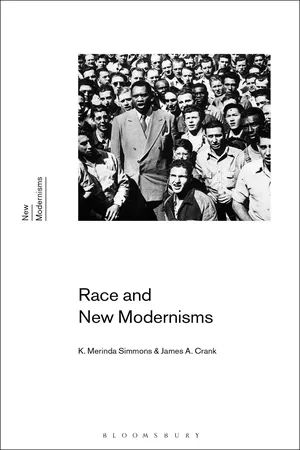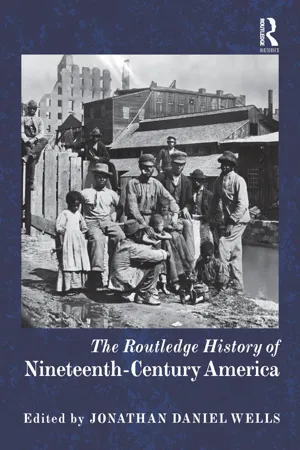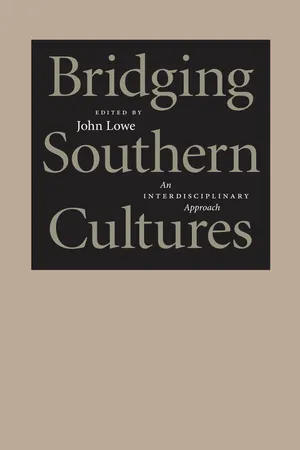History
Southern Renaissance
The Southern Renaissance was a cultural movement that emerged in the American South during the early 20th century. It was characterized by a renewed interest in Southern history, literature, and culture, and was marked by the emergence of writers such as William Faulkner, Flannery O'Connor, and Eudora Welty. The movement sought to challenge stereotypes about the South and to celebrate its unique cultural heritage.
Written by Perlego with AI-assistance
Related key terms
4 Key excerpts on "Southern Renaissance"
- eBook - ePub
- K. Merinda Simmons, James A. Crank(Authors)
- 2019(Publication Date)
- Bloomsbury Academic(Publisher)
Looking to provide an origin story for the creative wellspring, Richard King offers several theories in his A Southern Renaissance (1980) as to why the region became the fertile territory for modernist initiatives, including his idea that “the Renaissance was the product of the creative tension between the Southern past and the pressures of the modern world” (4). In these narratives about the beginning of a “Southern Renaissance”—themselves a rhetoric of exceptionalism—critics frequently offer up the presumed mindset of “the southern artist.” The features that shape this figure—decimated by the loss of shared ideals; scarred by the repeated tensions between economically and socially alienated nation and region; and burdened by an inescapable past with romanticized beauty—are emblematic of the conditions that animated the projects of modern artists across Europe as well. 1 Such origin narratives collapse southern exceptionalism and a presumed modernist agenda in the South, facilitating white anxiety and upper-middle-class intellectual hand wringing while ignoring the ways in which these regional and racial classifications shaped Jim Crow legislation and public policy. However, a binary between America and “the South” should be resisted as well, inasmuch as it creates an easy and troubling definition of the region as the worst of American culture—what Duck describes as “an anomalous South [that] regularly displace[s] fundamental questions about political affiliation from discourse concerning the nation-state” (3). This rhetorical dichotomy allows America to be associated with “democracy and change and the region with racism and tradition” (3). Thus, the critical questions and terms in this chapter help us complicate regional classifications of the South, race, and nation. These representational efforts were ideological moves rather than neutral descriptions, demonstrating the co-constitutive relationship between aesthetics and politics - Jonathan Daniel Wells(Author)
- 2017(Publication Date)
- Routledge(Publisher)
As with representative government itself, this is a literary history that requires some effort, beyond the acquisition of an aesthetic taste capable of distinguishing the upper classes from the lower. And entering this period by way of white female and African-American male and female writers is especially productive, as one will often find that the literature one is accustomed to celebrating can be strangely limited in its power to capture the problems, and therefore the promise, of this time. The embodiments of the nation’s ideological contradictions, African-American writers led the way in the quest for a discursive and philosophical stability that remains the single most influential feature of the literature that emerged from the period we still have reason to call the American Renaissance. Accordingly, African-American written responses to the challenges of their world provide us with a framework for understanding the vitality of this period, from the great popularity of women’s literature to the formal experimentations of such writers as Emerson, Melville, and Whitman. And when one witnesses the strategic use of conventional plots in women’s writing – writing produced by those who were most subject to the force of convention – one begins to understand why this literature was so eagerly and broadly embraced. And when one takes in the whole of the writings produced during this time, from the seedy to the sermonic, from tales of adventure to slave narratives that appealed to a sense of adventure to approach truths for which readers were wholly unprepared, one finds a literature roughly as glorious as the history of American governance. Not always an uplifting story, but one still strangely encouraging, at times even inspiring, and sometimes unexpectedly sublime. Call it the American Renaissance; call it what you will. It is a literary history unlike any other, and one still capable of instructing and inspiring readers – all readers, regardless of race, gender, religion, or class.Notes
1 Later the term American Renaissance was used to characterize the art and architecture of the later decades of the century. More recently, the title has been appropriated by a white supremacist website. I will be addressing only the American Renaissance that, still today, refers to antebellum American literature and culture.2 Walter Benn Michaels and Donald E. Pease, eds., The American Renaissance Reconsidered: Selected Papers from the English Institute, 1982–83 (Baltimore: Johns Hopkins University Press, 1985); “The Other American Renaissance” is a chapter in Jane Tompkins, Sensational Designs: The Cultural Work of American Fiction, 1790–1860 (New York: Oxford University Press, 1985); Thomas M. Allen, “South of the American Renaissance,” American Literary History 16.3 (2004), 496–508; Jay Grossman, Reconstituting the American Renaissance: Emerson, Whitman, and the Politics of Representation (Durham: Duke University Press, 2003); Renée Bergland, “The Native American Nineteenth Century: Rewriting the American Renaissance,” ESQ: A Journal of the American Renaissance 52.1–2 (2006), 141–154; Charlene Avallone, “What American Renaissance? The Gendered Genealogy of a Critical Discourse,” PMLA 112.5 (1997), 1102–1120; Russ Castronovo, “Death to the American Renaissance: History, Heidegger, Poe,” ESQ: A Journal of the American Renaissance- D. Quentin Miller(Author)
- 2016(Publication Date)
- Routledge(Publisher)
4 The Era of the Harlem RenaissanceThe period known as the Harlem Renaissance (also called the “New Negro” Renaissance) is mostly associated with the 1920s, though its beginnings can be traced to the years just prior, and some of its spirit continued to exist in the years just after, until the Great Depression brought about a new set of issues that further changed the nature of African American literature. During the 1920s, an unprecedented amount of black writing was published and accepted by the white literary establishment, promising not only a better future for race relations, but, equally importantly, a new sense of black race pride. F. Scott Fitzgerald dubbed the 1920s “The Jazz Age,” and the development of that musical form is central to other African American cultural developments at the time. But although some of the architects and builders of the Renaissance wanted it to be seen as a purely artistic movement, it is evident that the literary tug-of-war of the Reconstruction era between sociopolitical thought and art-for-art’s-sake continued.The word “renaissance” connotes a rebirth, but it also refers to a focused period of extraordinary cultural production. The Harlem Renaissance fulfills both connotations: a new optimism replaced the mood of cultural uncertainty that characterized black America in the late nineteenth and early twentieth centuries, and it manifested itself in a spectacular artistic outburst. There is some debate about whether or not the Harlem Renaissance was a spontaneous outpouring of art or a socially and politically manufactured phenomenon: a conscious attempt to atone for the failures of Reconstruction. David Levering Lewis writes, “The Harlem Renaissance was a somewhat forced phenomenon, a cultural nationalism of the parlor, institutionally encouraged and directed by leaders of the national civil rights establishment for the paramount purpose of improving race relations in a time of extreme national backlash, caused in large part by economic gains won by Afro-Americans during the Great War” (xiii). Nathan Irvin Huggins begins his essential study of the movement with the observation, “It is a rare and intriguing moment when a people decide that they are the instruments of history-making and race-building” (3).- eBook - ePub
Bridging Southern Cultures
An Interdisciplinary Approach
- John Lowe(Author)
- 2011(Publication Date)
- LSU Press(Publisher)
The construction of the Southern Literary Renaissance as a phenomenon of literary history, too, came largely from the pens of those like Allen Tate, thought in terms, and wrote in defense, of a particular southern identity. Some courses in, and anthologies of, southern literature continue to bear the marks of this canon. The introduction to a frequently reprinted anthology, Stories of the Modern South, suggests the Vanderbilt Agrarians were the “single intellectual phenomenon” in the modern South, ignoring Howard Odum and the liberal sociologists in Chapel Hill. Interestingly, male and, later, female African American voices entered the southern canon before those of progressive white women and men. Southern white women who wrote about union organizing and the Communist party, who wrote of sexual (heterosexual or lesbian) experience or Civil Rights movement activism, or who combined stylistic with gender experimentation, have only recently received attention from southernists. 10 And though other white women writers like Eudora Welty, Katherine Anne Porter, and Flannery O’Connor, have received ample attention from southernists, in the past their texts were read formally and stylistically, rarely against the grain. More gloomily, the role of scapegoat for the nation that the stereotyped South and stereotypical southerners have played for so long has disappeared neither from the popular imagination nor from, were we to be honest, the unspoken premises of many in the academy. While southern literary study takes place within a regional disciplinary history whose New Critical theoretical assumptions, though now contested, have sustained the sense of difference and distinctiveness that makes southern literature so apparently distasteful to outsiders, the study of southern history does not
Learn about this page
Index pages curate the most relevant extracts from our library of academic textbooks. They’ve been created using an in-house natural language model (NLM), each adding context and meaning to key research topics.



